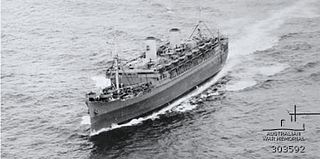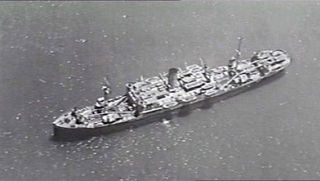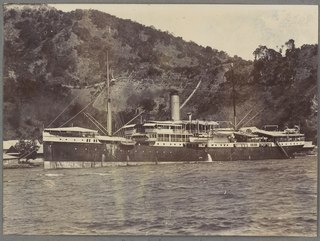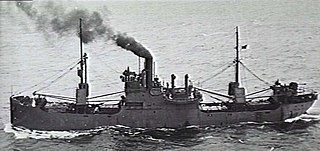USS Florence Nightingale (AP-70) was a Maritime Commission type C3-M cargo ship built as Mormacsun for Moore-McCormack Lines. Mormacsun operated for Moore-McCormack from May 1941 until December 1941 when she came under the War Shipping Administration (WSA) for the duration of World War II. The ship operated with Moore-McCormack as the WSA agent, playing an important role in early supply of the Southwest Pacific, until transfer to the United States Navy September 1942 and commissioning as Florence Nightingale whereupon she became an Elizabeth C. Stanton-class transport ship. She was named for Florence Nightingale (1820–1910), the nursing pioneer, and is one of the few United States Navy ships named after a woman. The ship was returned to WSA in 1946 and then to Moore-McCormack operating as Mormacsun until sold to operate as Japan Transport and lastly as Texas.

The third USS Dale (DD-290) was a Clemson-class destroyer in the United States Navy. She was named for Richard Dale.
USS Leonis (AK-128) was a Crater-class cargo ship in service with the US Navy in World War II. It was the only ship of the Navy to have borne this name, Latin for "of a lion", presumably referring to the northern constellation Leo.
USS Venus (AK-135) was a Crater-class cargo ship in the service of the United States Navy in World War II. Originally liberty ship SS William Williams, named after William Williams, a signer of the Declaration of Independence, it was taken over by the Navy after being damaged in a torpedo attack and renamed after the planet Venus. It was the only ship of the Navy to bear this name.

SS Mariposa was a luxury ocean liner launched in 1931, one of four ships in the Matson Lines "White Fleet", which included SS Monterey, SS Malolo, and SS Lurline. She was later renamed SS Homeric.

USS Triangulum (AK-102) was a Crater-class cargo ship commissioned by the US Navy for service in World War II. Triangulum was named after the constellation Triangulum. She was responsible for delivering troops, goods and equipment to locations in the Asiatic-Pacific Theater.

USS Ganymede (AK-104) was a Crater-class cargo ship commissioned by the US Navy for service in World War II. She was responsible for delivering troops, goods and equipment to locations in the war zone. Named after the largest of the moons of Jupiter, Ganymede was the only ship of the Navy to bear this name.

Koninklijke Paketvaart-Maatschappij, better known as KPM, was a Dutch shipping company (1888–1966) in the Netherlands East Indies, now Indonesia. It was the dominant inter-island shipping line in Indonesia during the last half century of the colonial era.

SS 's Jacob Dutch freighter built by Maatschappij Fijenoord, Rotterdam, Netherlands, in 1907, of 2,839 GRT and operated by Koninklijke Paketvaart-Maatschappij (KPM) in the Dutch East Indies trade. The ship, after seeking refuge in Australia during the Japanese invasion of the islands, became part of the Southwest Pacific Area (SWPA) command's permanent local fleet. 's Jacob was sunk off Papua New Guinea on 8 March 1943 during World War II by Japanese air attack.

Operation Lilliput was the name given to a convoy operation directed by G.H.Q. Operations Instructions Number 21 of 20 October 1942 for transportation of troops, weapons, and supplies in a regular transport service between Milne Bay and Oro Bay, New Guinea between 18 December 1942 and June 1943 in order "to cover reinforcement, supply, and development of the Buna-Gona area upon its anticipated capture" by the Australian 7th Division and the United States Army's 32d Division. Within six months, the convoys, escorted by Royal Australian Navy corvettes and largely composed of Dutch KPM merchant ships, had delivered 60,000 tons of supplies and 3,802 troops from Milne Bay to Oro Bay. Corvettes provided the majority of the escort force. Losses during Imperial Japanese air attacks amounted to two merchant ships, 's Jacob and Van Heemskerk, sunk and two badly damaged while several of the corvettes also sustained damage and casualties.

SS Tasman was a 4,922 gross register tons (GRT) Dutch steamship built by Earle's Shipbuilding and Engineering Company Limited, Hull in 1921 for Koninklijke Paketvaart-Maatschappij (KPM), Batavia. With outbreak of the war in the Pacific and the fall of the Dutch East Indies, Tasman was one of 21 KPM vessels that sought refuge in Australia. These ships became the core of the initial Southwest Pacific Area (SWPA) command's permanent local fleet under U.S. Army control. After general service as a transport, the ship was converted to a hospital ship at Melbourne. The ship, under the Dutch flag and Dutch certification under the Hague Convention, served the remainder of the war as a Dutch hospital ship.

MS Sea Witch was a United States Maritime Commission type C2 cargo ship, the first of four pre-war hulls, built by Tampa Shipbuilding & Engineering Company, Tampa, Florida and delivered in July 1940. The ship was of the basic C2 design, rather than the more numerous C2-S, C2-S-A1, C2-S-B1 types and four C2-T hulls delivered December 1941 through March 1942. Sea Witch was one of the relatively few C2 types built with diesel engines.

Registan, built 1910, was the first name for a ship serving fifty years under the later names Guantanamo, USS Guantanamo (ID-1637), Comerio, Vittorin, Grey Lag and finally Hai Lung until scrapping in 1960. The ship transported gunpowder and munitions during World War I as USS Guantanamo and as a cargo ship during World War II for the War Shipping Administration (WSA). After 12 October 1943 the ship was assigned to the Southwest Pacific Area command's permanent local fleet as the United States Army transport Grey Lag with that fleet's number X-101. In April 1945 she was one of the transports towing large barges from Australia and New Guinea to the Philippines after that concept to mitigate shipping shortages had been proven feasible. In 1946 the ship was sold to the Republic of China and renamed Hai Lung.

Contessa was a refrigerated cargo and passenger ship of 5,512 GRT built by Barclay, Curle & Co., Glasgow for Vaccaro Brothers & Company launched 18 February 1930. The ship, along with sister ship Cefalu, served ports in the United States, Cuba, and Central America specifically La Ceiba, Honduras which is still a port for the fruit trade. The ship became part of the Standard Fruit Company, a company established by Vaccaro Brothers, and operated as a cargo passenger vessel until taken over at New Orleans by the War Shipping Administration (WSA) on 29 May 1942 with Standard Fruit Company remaining as the WSA operating agent. The ship was later bareboat sub chartered to the United States War Department 14 July 1943 and operated in the Army's Southwest Pacific Area local fleet under the local fleet number X-96 from 18 September 1943 into 1945 as a troop ship. The ship was returned to WSA with Standard Fruit again its agent on 28 May 1946 in Brooklyn until returned to the company for commercial operation at New Orleans on 20 August 1947.

SS Karsik was a German-built cargo steamship. Deutsche Schiff- und Maschinenbau (Deschimag) built her as Soneck for Deutsche Dampfschifffahrts-Gesellschaft "Hansa" in 1938.

SS Japara was a freighter of 3,323 GRT built by Mach. Fabr. & Scheepswerf P. Smit Jr., Rotterdam in 1930 and operated by Koninklijke Paketvaart-Maatschappij (KPM) in the Dutch East Indies trade. The 1930 Japara was operating with the United States Army permanent local fleet of the U.S. Army Forces in Australia (USAFIA) from 1942 until 1945 even while the larger ship, 9,312 GRT MS Japara (1938), was active in Army service oceanwide. Japara of 1930 played an important logistics role in the New Guinea Campaign.

SS Van Heemskerk was a freighter built by N.V. Nederlandsche Scheepsbouw-Maatschappij with engines built by Nederlandsche Fabriek van Werktuigen & Spoorwegmaterieel N.V, both of Amsterdam, Netherlands. The ship of 2,996 GRT was launched 31 August 1909 and delivered 29 October 1909 for operation by Koninklijke Paketvaart-Maatschappij (KPM) in the Dutch East Indies trade.

SS Lake Elsmere was an Emergency Fleet Corporation (EFC) Design 1074 cargo ship built for the United States Shipping Board (USSB) during the massive shipbuilding effort of World War I.

MS Van Heutsz was a Dutch diesel powered passenger and cargo vessel of the Koninklijke Paketvaart-Maatschappij (KPM) line operating from Batavia in the Dutch East Indies. The ship, as was sister ship Cremer, was designed for the longer routes of the East Indies inter-island trade extending to Singapore and Hong Kong. The ships had limited cabin accommodation for passengers but large deck passenger capacity. Much of the passenger trade was with Chinese moving between China, Singapore and the East Indies.

















